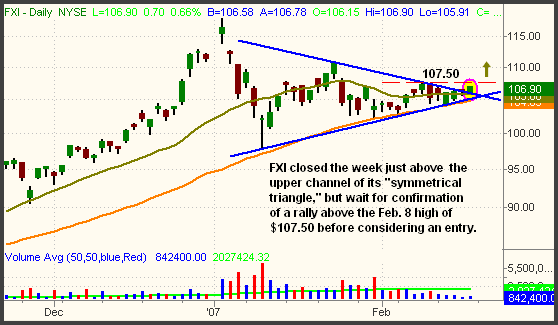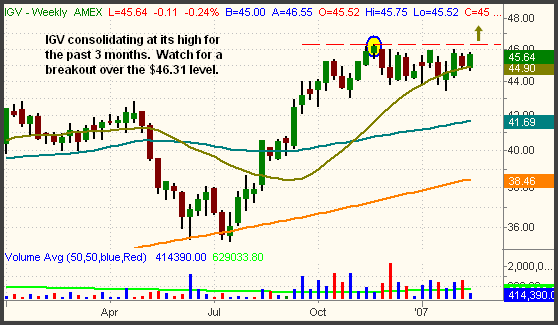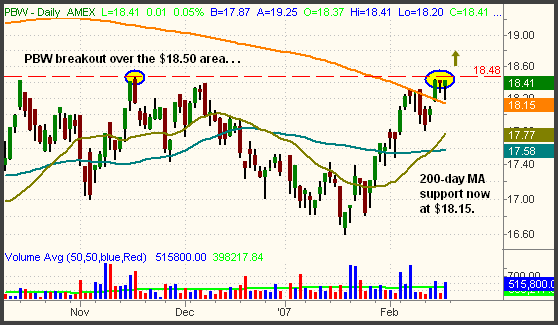| The Wagner Daily ETF Report for February 20 |
| By Deron Wagner |
Published
02/20/2007
|
Stocks
|
Unrated
|
|
|
|
The Wagner Daily ETF Report for February 20
Negative news from software titan Microsoft Corp. caused the Nasdaq Composite to fall 0.6% last Friday morning, but the resilient index recovered to finish the day flat. The S&P 500 also shook off morning weakness and closed only 0.1% lower. The Dow Jones Industrial Average was unchanged, but the small-cap Russell 2000 and S&P Midcap 400 indices were higher by 0.3% and 0.1% respectively. Though intraday trading ranges of the major indices were tight, each index still finished near its high of the day.
Typical to Fridays that precede three-day holiday weekends, turnover declined in both exchanges. Total volume in the NYSE was 2% lighter than the previous day's level, while volume in the Nasdaq ticked 4% lower. Despite two sessions of higher volume gains ("accumulation days") on February 13 and 14, NYSE volume levels remained below average every day last week. The Nasdaq scored an "accumulation day" only on February 14, but turnover that day was firmly above its 50-day average level.
Last week, the S&P 500 gained 1.2% and the Dow rallied 1.4%, but the lighter than average volume tells us the gains resulted more from a lack of sellers than an abundance of buyers. Markets will obviously rise whenever demand exceeds supply, but strong institutional buying is required in order for price appreciation to be sustained. Without it, weeks of low volume gains can easily be wiped out by one or two days of high volume selling ("distribution"). Daily monitoring of the broad market's price to volume relationship is the best way to know what is really happening "under the hood," something the major financial media outlets rarely discuss.
Going into the new week, there are a couple ETFs we are monitoring for potential entry. Initially discussed in the February 15 issue of The Wagner Daily, we continue to stalk iShares China (FXI) for a breakout of its "symmetrical triangle" pattern. FXI closed the week just above the upper channel of its triangle, but not by a wide enough margin to confirm a bullish breakout. However, confirmation should come on a rally above its February 8 high of 107.50. The dashed horizontal line marks this level:

If FXI makes a convincing move above the 107.50 level, it will present a low-risk buy entry, but immediately setting a protective stop is recommended. "Symmetrical triangles" can be highly profitable chart patterns, but they often make a false move ("stop hunt") in the opposite direction before following through in the real direction. As such, a tight stop is necessary in order to protect against a false upside breakout.
All the other industry sector ETFs we discussed last week still look good for potential breakout this week. To recap, they were: iShares Software (IGV), StreetTRACKS Metal & Mining (XME), and PowerShares Clean Energy (PBW). Their breakout levels are illustrated on each of the charts below:



In addition to the above, the iShares Transportation (IYT) could add to its recent gains. It rocketed to a new all-time high after we pointed out the "bull flag" chart pattern on the morning of February 13. As you may have noticed, all the above ETFs are correlated to industry sectors as opposed to the broad market. Simply put, we don't trust the lack of momentum in the major indices. Although several indexes are at multi-year or record highs, the market has basically been at a standstill for the past few weeks. The overall lack of high volume explains why the market has lacked momentum on the way up. Trading specific industry sectors with relative strength is a good way to reduce your risk in the event of a rapid market reversal. Sector ETFs with relative strength will outperform the broad market on the "up" days, but will also be the last to fall when the stock market inevitably corrects.
Deron Wagner is the Founder and Head Trader of both Morpheus Capital LP, a U.S. hedge fund, and Morpheus Trading Group, a trader education firm launched in 2001 that provides daily technical analysis of the leading ETFs and stocks. For a free trial to the full version of The Wagner Daily or to learn about Wagner's other services, visit MorpheusTrading.com or send an e-mail to deron@morpheustrading.com.
|